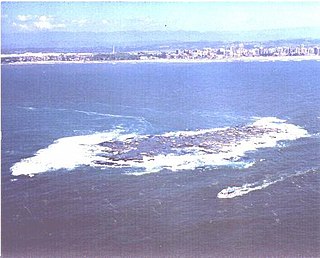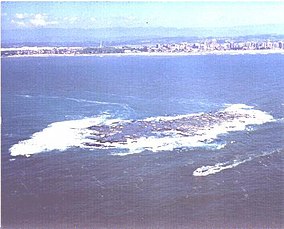
Angra dos Reis is a municipality located in the southern part of the Brazilian state of Rio de Janeiro. The city is located by the sea and includes in its territory many offshore islands, the largest being Ilha Grande.

Torres is a city on the coast of south Brazil in the state of Rio Grande do Sul. The city has a population of approximately 40,000 inhabitants, of which 10,000 live in rural zones, but in summer the number of inhabitants reaches 300,000.

Santa Catarina Island is an island in the Brazilian state of Santa Catarina, located off the southern coast. It is home to the state capital, Florianópolis.

Jericoacoara National Park is a national park of Brazil, located in the municipality of Jijoca de Jericoacoara, state of Ceará. On its seashore is located the famous Jericoacoara Beach.

The coastline of Brazil measures 7,491 km, making it the 16th longest national coastline in the world. The coastline touches exclusively the Atlantic Ocean. Brazil's coastline has many geographical features such as islands, reefs, bays, and its 2,095 beaches.

Praia do Sul State Biological Reserve is a biological reserve on the island of Ilha Grande, in the State of Rio de Janeiro, in Brazil.

The Order of Aeronautical Merit is an award of the Brazilian Air Force, established on 1 November 1943 by President Getúlio Vargas. The order is presented in five grades and recognizes distinguished service and exceptional contributions to the Brazilian Air Force.
The Protected Areas of the Azores are the basic administrative-territorial and conservation structures in the archipelago of the Azores and the surrounding oceans. The areas integrate the entirety of the Azores within its Exclusive Economic Zone, as well as the surrounding waters, under the international agreements and conventions. The network realizes the categorization of management for protected areas adopted by the International Union for Conservation of Nature (IUCN), adapting it to the specific geographical, environmental, cultural and political-administrative territory of the archipelago.

The following is a list of the orders, decorations, and medals of Brazil:

Santa Maria Natural Park is a protected area on Santa Maria Island in the Azores. The park was created by the Secretaria Regional do Ambiente e do Mar, of the Autonomous Regional Government of the Azores to better manage the protected areas of Santa Maria Island. Several natural landscapes were preserved and their use conditioned in order to foster conservation and support endemic flora and fauna species, as well as provide communal forms of recreation and nature interpretation.
Academic ranks in Portugal and Brazil are the titles, relative importance and power of professors, researchers, and administrative personnel held in academia.

A Wildlife refuge in Brazil is a type of strictly protected area of Brazil defined by law. The purpose of the wildlife refuge is to ensure survival or reproduction of a species or community of flora or fauna, with access rules defined by the administrative agency.

A biological reserve in Brazil is a legally defined type of protected area of Brazil, a conservation unit that aims for full preservation of biota and other natural attributes without human interference. It may be visited only with prior approval of the responsible agency, and only for research or educational purposes.

A national forest in Brazil is a type of sustainable use protected area. The primary purpose is sustainable exploitation of the forest, subject to various limits. These include a requirement to preserve at least 50% of the original forest, to preserve forest along watercourses and on steep slopes, and so on. More than 10% of the Amazon rainforest is protected by national forests or other types of conservation unit.

A state park in Brazil is a legally defined type of protected area operated by one of the states. Their goal is to preserve important or beautiful natural ecosystems. Public access is allowed subject to regulations defined by the responsible agency.

A state forest in Brazil is a type of sustainable use protected area managed at the state level. The primary purpose is sustainable exploitation of the forest, subject to various limits. These include a requirement to preserve at least 50% of the original forest, to preserve forest along watercourses and on steep slopes, and so on.

The Jureia-Itatins Ecological Station is an ecological station (ESEC) in the state of São Paulo, Brazil. It fully protects a well-preserved area of Atlantic Forest and associated ecosystems along the coastal plain and mountains of the south of the state, home to endangered species of mammals and birds. There is however, some threat from illegal gathering of heart of palm.
The Banhados de Iguape Ecological Station is an ecological station in the state of São Paulo, Brazil. It protects an area of mangrove swamp. Since 2013 it has been administered as part of the Juréia-Itatins Ecological Station.

The Aventureiro Sustainable Development Reserve, formerly the Aventureiro Marine State Park, is a sustainable development reserve in the state of Rio de Janeiro, Brazil. It supports artisanal fishing by a small traditional community on the Ilha Grande, an island off the southwest coast of the state.
A municipal nature park in Brazil is a type of protected area operated by one of the municipalities. Their goal is to preserve important or beautiful natural ecosystems. Public access is allowed subject to regulations defined by the responsible agency.


















